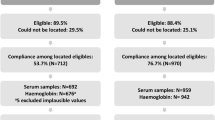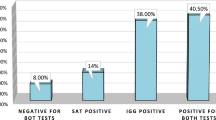Abstract
To gain more understanding of the epidemiology ofCampylobacter pylori infection, the immune response to the organism was studied in the following selected potential risk groups: endoscopy staff (n=45), dental staff (n=58), orphanage children (n=24), psychiatric patients (n=58), and family contacts ofCampylobacter pylori-infected patients (n=55). The frequency of an IgG and IgA antibody response in the different groups was determined by the immunoblot method and compared with that in an appropriate control group (n=189). The frequency of a positive antibody response was dependent on age (p<0.0001) but not on sex. When results were corrected for age by logistic regression analysis, all groups, with the exception of dental staff and orphanage children, revealed a significantly raised frequency of an IgA and combined IgG/IgA immune response compared to controls. There was not a significant difference for the IgG response, except in orphanage children. It is concluded that endoscopy staff, family contacts ofCampylobacter pylori-infected patients and people living in closed communities such as psychiatric patients and orphanage children must be considered as risk groups forCampylobacter pylori infection. The findings support the notion that person-to-person spread and a common source are the predominant modes of transmission ofCampylobacter pylori in addition to endoscopes.
Similar content being viewed by others
References
Warren, J. R., Marshall, B. J. Unidentified curved bacilli on gastric epithelium in active chronic gastritis. Lancet 1983, i: 1273–1275.
Ramsey, E. J., Carey, K. V., Peterson, W. L., Jackson, J. J., Murphy, F. K., Read, N. W., Taylor, K. B., Trier, J. S., Fordtran, J. S. Epidemic gastritis with hypochlorhydria. Gastroenterology 1979, 76: 1449–1457.
Berkowicz, J., Lee, A. Person to person transmission ofCampylobacter pylori. Lancet 1987, ii: 680–681.
Mitchell, M., Bohane, T. D., Berkowicz, J., Hazell, S. L., Lee, A. Antibody toCampylobacter pylori in families of index children with gastrointestinal illness due toCampylobacter pylori. Lancet 1987, ii: 681–682.
Marshall, B. J., McGechie, D. B., Francis, G. J., Utley, P. J. Pyloric campylobacter serology. Lancet 1984, ii: 281.
Jones, D. M., Lesses, A. M., Eldridge, J. Campylobacter-like organisms on the gastric mucosa: culture, histological, and serological studies. Journal of Clinical Pathology 1984, 37: 1002–1006.
von Wulffen, H., Heesemann, J., Bützow, G. H., Löning, T., Laufs, R. Detection ofCampylobacter pyloridis in patients with antrum gastritis and peptic ulcers by culture, complement fixation test and immunoblot. Journal of Clinical Microbiology 1986, 24: 716–720.
Goodwin, C. S., Blincow, E., Peterson, G., Sanderson, C., Cheng, W., Marshall, B., Warren, J. R., McCulloch, R. Enzyme-linked immunosorbent assay forCampylobacter pyloridis: correlation with presence ofCampylobacter pyloridis in the gastric mucosa. Journal of Infectious Disease 1987, 155: 488–494.
Jones, D. M., Eldrigde, J., Fox, A. J., Sethi, P., Whorwell, P. J. Antibody to the gastric campylobacter-like organism (“Campylobacter pyloridis”). Clinical correlations and distribution in the normal population. Journal of Medical Microbiology 1986, 22: 57–62.
Kaldor, J., Tee, W., McCarthy, P., Watson, J., Dwyer, B. Immune response toCampylobacter pyloridis in patients with peptic ulceration. Lancet 1985, i: 921.
von Wulffen, H., Grote, H. J. Enzyme-linked immunosorbent assay for detection of immunglobulin A and G antibodies toCampylobacter pylori. European Journal of Clinical Microbiology and Infectious Diseases 1988, 7: 559–565.
von Wulffen, H., Grote, H. J., Gatermann, S., Löning, T., Berger, B., Buhl, C. Immunoblot analysis of immune response toCampylobacter pylori and its clinical associations. Journal of Clinical Pathology 1988, 41: 440–446.
Perez-Perez, G. J., Blaser, M. J. Conservation and diversity ofCampylobacter pyloridis major antigens. Infection and Immunity 1987, 55: 1256–1263.
Newell, D. G. Identification of the outer membrane proteins ofCampylobacter pyloridis and antigenic cross-reactivity betweenCampylobacter pyloridis andCampylobacter jejuni. Journal of General Microbiology 1987, 133: 163–170.
Apel, I., Kist, M., Jacobs, E., Bredt, W. Antibody response of patients against a 120 kDa surface protein ofCampylobacter pylori. Zentralblatt für Bakteriologie, Mikrobiologie und Hygiene (A) 1988, 268: 271–276.
Laemmli, U. K. Cleavage of structural proteins during the assembly of the head of bacteriophage T4. Nature 1970, 227: 680–685.
Jones, D. M., Curry, A.: Ultrastructural study of gastric campylobacter-like organisms from man, baboon, pig and ferret. In: Kaijser, B., Falsen, E. (ed.) Campylobacter IV. University of Göteborg, 1988, p. 109.
Gullini, S., Boccini, S., Contarini, D., Macario, F., Bosso, O., Maini, P., Bicocchi, R. Is transmission ofCampylobacter pylori by endoscopy examination possible? Endoscopy 1988, 20: 162.
Gledhill, T., Leicester, R. J., Addis, B., Lightfoot, N., Barnard, J., Viney, N., Darkin, D., Hunt, R. H. Epidemic hypochlorhydria. British Medical Journal 1985, 290: 1383–1386.
Hunt, R. H., Darkin, D. Epidemic hypochlorhydria. British Medical Journal 1985, 291: 53.
Schaub, N., Stalder, H., Stalder, G. A., Marbet, U. A., Vögtlin, J., Affolter, H., Wegmann, W., Vischer, W. A., Zingel, O., Tanner, K., Dietrich, F. M. Campylobacter pylori, Gastritis und Ulcuskrankheit. Schweizerische Medizinische Wochenschrift 1988, 118: 293–301.
Graham, D. Y., Klein, P. D., Opekun, A. R., Boutton, T. W., Evans, D. J., Evans, D. G., Alpert, L. C., Michaletz, P. A., Yoshimura, H. H., Adam, E. Epidemiology ofCampylobacter pylori infection: ethnic considerations. Scandinavian Journal of Gastroenterology 1988, 23, Supplement 142: 9–13.
Vaira, D., Holton, J., Cairns, S. R., Falzon, M., Polydorou, A., Dowsett, J. F., Salmon, P. R. Antibody titres toCampylobacter pylori after treatment for gastritis. British Medical Journal 1988, 297: 397–398.
Author information
Authors and Affiliations
Rights and permissions
About this article
Cite this article
Reiff, A., Jacobs, E. & Kist, M. Seroepidemiological study of the immune response toCampylobacter pylori in potential risk groups. Eur. J. Clin. Microbiol. Infect. Dis. 8, 592–596 (1989). https://doi.org/10.1007/BF01968135
Issue Date:
DOI: https://doi.org/10.1007/BF01968135




